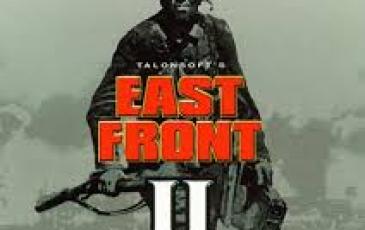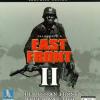Ode to Panzerblitz - Tactical Game 3 (6 Scenarios) - The Matrix Games version of East Front II

| Rating: | 0 (0) |
| Games Played: | 0 |
| SM: | 2 |
| Turns: | 12 |
| Type: | Custom |
| First Side: | Axis |
| Second Side: | USSR |
| Downloads: | 392 |
TACTICAL GAME #3 DESIGN NOTES By Alan R. Arvold
Many wargames have their origins from somewhere and the game of Panzerblitz is no exception. It just didn't appear in the fall of 1970 out of nowhere, it came from another game, a test game mind you, but a game never-the-less. Many players are ignorant of the story of its origins. So here is the short history of it.
Back in 1968 one James Dunnigan, basking in the success of game Jutland where he converted naval miniatures to a boardgame format, decided to do it again, this time with AFV miniatures. He chose the Eastern Front in 1944 as his back drop since that time period had plenty of different tanks and assault guns to use on both sides. The playtest game he designed for this was named State Farm 69. The game had counters representing single tanks or anti-tank guns and could be played on a tabletop or the floor, much the same way as Jutland was played. The game was simple and fun to play but Dunnigan wanted to take it further. Pretty soon one of the play testers at Poultron Press where Dunnigan worked came up with a conversion to play the game on a hexigon wargame map. Dunnigan liked the idea and as his wont, adopted the idea as his own and soon expanded the simple game, adding infantry squads, terrain to the map, weather effects, off and on the board artillery, and much more. Within six months the game, which he renamed Highway 61, became a monstrosity which became just about impossible to play as it was so complex. It had become the Advance Squad Leader of its day in a time when wargame play mechanics did not allow games at that tactical level to be played. So Dunnigan had to start over again.
It was now 1969 and Dunnigan still wanted convert miniature land battles to a boardgame format, indeed he had started a series of test games to cover land warfare in many different eras of history. These were not end products in themselves, they were mere vehicles to test out various ideas from which proper games could be designed and developed from the results of these test games. The difference with these games was that they were sent out to play testers all across the country, instead of being confined to within house. Tactical Game #3 was Dunnigan's test game for armored warfare on the Eastern Front in 1944. It had simple rules and more importantly, six scenarios to play out. In order to keep it simple, Dunnigan had to raise the tactical level to the platoon/company level. As a result, many new ideas came into Poultron Press for it and Dunnigan was able to develop a proper game from them from which the end result would be Panzerblitz. As he was developing it, Avalon Hill expressed interest in publishing it in the fall of 1970. Dunnigan made a deal with them where he would complete the game and then deliver it to them. This he did, the game premiered in October 1970, and the rest is history.
Panzerblitz is considered to be the patriarch of all tactical armored warfare games ever made in the wargaming hobby/business. The video game East Front has been considered to be the ultimate expression of Panzerblitz in a computer game. This makes sense considering that James Dunnigan was on the original design team for East Front back in the late Nineties. As such, I have paid homage to the original Panzerblitz by converting the original scenarios from the game, as well as those from the various articles published in the Avalon Hill General magazine, to East Front over the years. Having completed this long task I then decided to pay homage to the father of Panzerblitz, the test game Tactical Game 3.
The mapsheet is rather sparse when it comes to terrain. The Orders of Battle are fictional, with the unit designations being made up. The scenarios do not depict historical battles. Rather they depict common tactical situations that both sides encountered during the time period in question. So what good are these scenarios in East Front? Well they are far more simpler than even the Boot Camp scenarios and would be a way to introduce a player new to the campaign system to the game.
Okay, these scenarios are not much to write home about. But besides being introductory in nature, they help preserve another piece of wargaming history for future players.
Many wargames have their origins from somewhere and the game of Panzerblitz is no exception. It just didn't appear in the fall of 1970 out of nowhere, it came from another game, a test game mind you, but a game never-the-less. Many players are ignorant of the story of its origins. So here is the short history of it.
Back in 1968 one James Dunnigan, basking in the success of game Jutland where he converted naval miniatures to a boardgame format, decided to do it again, this time with AFV miniatures. He chose the Eastern Front in 1944 as his back drop since that time period had plenty of different tanks and assault guns to use on both sides. The playtest game he designed for this was named State Farm 69. The game had counters representing single tanks or anti-tank guns and could be played on a tabletop or the floor, much the same way as Jutland was played. The game was simple and fun to play but Dunnigan wanted to take it further. Pretty soon one of the play testers at Poultron Press where Dunnigan worked came up with a conversion to play the game on a hexigon wargame map. Dunnigan liked the idea and as his wont, adopted the idea as his own and soon expanded the simple game, adding infantry squads, terrain to the map, weather effects, off and on the board artillery, and much more. Within six months the game, which he renamed Highway 61, became a monstrosity which became just about impossible to play as it was so complex. It had become the Advance Squad Leader of its day in a time when wargame play mechanics did not allow games at that tactical level to be played. So Dunnigan had to start over again.
It was now 1969 and Dunnigan still wanted convert miniature land battles to a boardgame format, indeed he had started a series of test games to cover land warfare in many different eras of history. These were not end products in themselves, they were mere vehicles to test out various ideas from which proper games could be designed and developed from the results of these test games. The difference with these games was that they were sent out to play testers all across the country, instead of being confined to within house. Tactical Game #3 was Dunnigan's test game for armored warfare on the Eastern Front in 1944. It had simple rules and more importantly, six scenarios to play out. In order to keep it simple, Dunnigan had to raise the tactical level to the platoon/company level. As a result, many new ideas came into Poultron Press for it and Dunnigan was able to develop a proper game from them from which the end result would be Panzerblitz. As he was developing it, Avalon Hill expressed interest in publishing it in the fall of 1970. Dunnigan made a deal with them where he would complete the game and then deliver it to them. This he did, the game premiered in October 1970, and the rest is history.
Panzerblitz is considered to be the patriarch of all tactical armored warfare games ever made in the wargaming hobby/business. The video game East Front has been considered to be the ultimate expression of Panzerblitz in a computer game. This makes sense considering that James Dunnigan was on the original design team for East Front back in the late Nineties. As such, I have paid homage to the original Panzerblitz by converting the original scenarios from the game, as well as those from the various articles published in the Avalon Hill General magazine, to East Front over the years. Having completed this long task I then decided to pay homage to the father of Panzerblitz, the test game Tactical Game 3.
The mapsheet is rather sparse when it comes to terrain. The Orders of Battle are fictional, with the unit designations being made up. The scenarios do not depict historical battles. Rather they depict common tactical situations that both sides encountered during the time period in question. So what good are these scenarios in East Front? Well they are far more simpler than even the Boot Camp scenarios and would be a way to introduce a player new to the campaign system to the game.
Okay, these scenarios are not much to write home about. But besides being introductory in nature, they help preserve another piece of wargaming history for future players.























